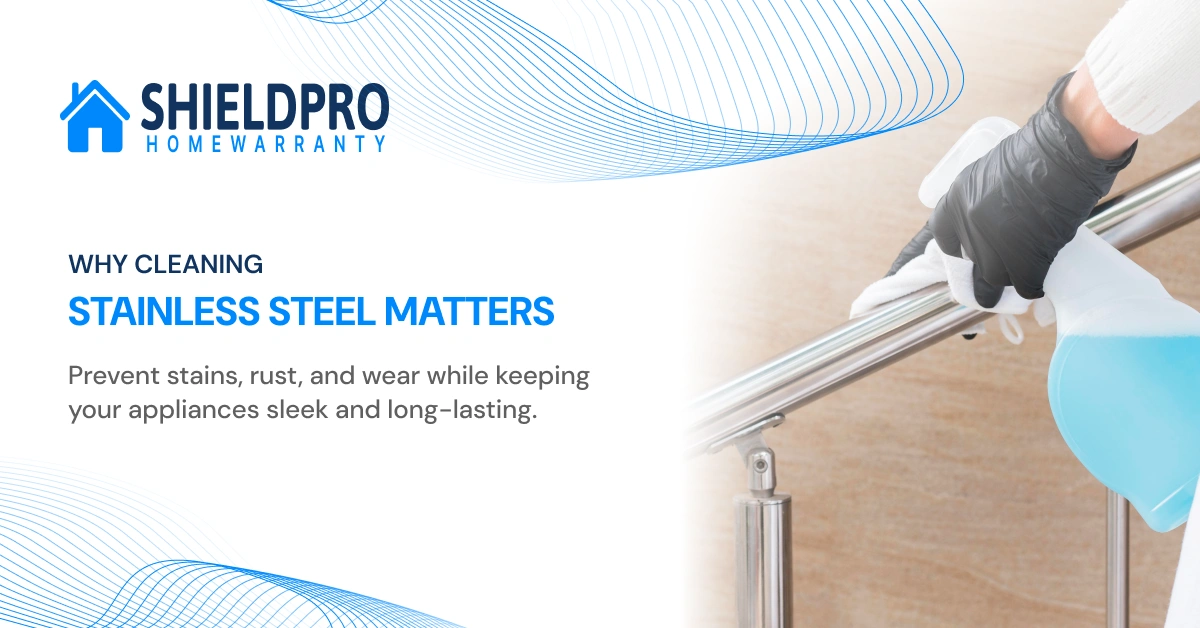
Stainless steel has become a centerpiece of modern homes from shiny refrigerators to sleek sinks and professional-grade cookware. Its appeal lies in durability, elegance, and resistance to rust. But as any homeowner knows, cleaning stainless steel surfaces isn’t always simple. Smudges, fingerprints, water spots, streaks, and even small rust marks can quickly dull its polished finish.
The good news? With the right techniques, you can restore that mirror-like shine and keep your appliances looking modern for years. This in-depth guide will teach you how to clean stainless steel appliances, sinks, and cookware while avoiding common mistakes that often damage the finish.
Why Cleaning a Stainless Steel Matters
Stainless steel is tough, but it isn’t invincible. Regular cleaning not only improves appearance but also prevents long-term damage. Here’s why it matters:
- Smudge Control: Stainless steel attracts fingerprints like a magnet, especially on refrigerators and dishwashers.
- Water Stains: Hard water deposits leave mineral spots that ruin the sleek look.
- Rust Prevention: Improper cleaners or scratches can cause rust to form.
- Longevity: Proper care keeps your metal shining and prevents costly replacements.
If you care about maintaining your home’s aesthetics, cleaning stainless steel correctly should be part of your routine.
Everyday Cleaning for Stainless Steel
For daily maintenance, you don’t need expensive cleaners. A simple soap-and-water solution works wonders.
Step-by-Step Daily Cleaning Routine
- Mix: Add a few drops of mild dish soap to a bowl of warm water.
- Dampen: Dip a microfiber cloth into the mixture and wring it out.
- Wipe: Gently clean the surface, following the grain of the metal.
- Rinse: Use a fresh cloth with clean water to remove soap residue.
- Dry: Wipe with a soft towel to prevent streaks or water spots.
Pro Tip: Always use microfiber cloths. Paper towels or abrasive sponges can leave micro-scratches.
Removing Fingerprints and Streaks
One of the biggest frustrations with stainless steel is fingerprint buildup. Luckily, there are easy solutions.
Vinegar Spray Method
- Fill a spray bottle with undiluted white vinegar.
- Spray directly onto the metal.
- Wipe with a microfiber cloth, moving with the grain.
- Dry thoroughly for a streak-free finish.
Club Soda Trick
- Spray club soda onto the surface.
- Wipe clean for an instant polish that leaves no streaks.
Oil Polish Method
After cleaning, apply a pea-sized drop of mineral oil or olive oil to a microfiber cloth. Gently buff the surface to create a shiny, fingerprint-resistant finish.
Deep Cleaning Stainless Steel (For Stains & Rust)
Sometimes, everyday cleaning isn’t enough. Here’s how to tackle stubborn stains and minor rust spots.
Baking Soda Paste (For Stains and Rust)
- Mix 3 parts baking soda with 1 part water.
- Apply the paste directly to stained or rusted areas.
- Let it sit for 10 minutes.
- Scrub gently with a non-abrasive sponge.
- Rinse thoroughly and dry.
Lemon & Baking Soda for Shine
For cookware, sprinkle baking soda in the pan, add a squeeze of lemon juice, and scrub gently to remove discoloration.
Steam Cleaning
For hardened food particles (like on stovetops):
- Use a steam cleaner or boil water nearby to loosen debris.
- Wipe away with a microfiber cloth.
Cleaning Stainless Steel Appliances
Different appliances require slightly different cleaning methods.
Refrigerator:
- Use vinegar spray for fingerprints.
- Follow with an oil polish for long-lasting shine.
Dishwasher:
- Clean the exterior with soap and vinegar.
- Inside: Run an empty cycle with vinegar to prevent buildup.
Oven & Range Hood:
- Use a baking soda paste for grease spots.
- Finish with a vinegar spray.
Microwave:
- Clean the exterior with mild soap.
- Avoid abrasive scrubbing on handles.
Cleaning Stainless Steel Sinks
Stainless steel sinks face heavy wear from water, food, and utensils.
- Rinse the sink with warm water.
- Sprinkle baking soda across the surface.
- Scrub with a soft sponge, following the grain.
- Rinse thoroughly with vinegar to kill bacteria.
- Dry immediately to prevent water spots.
- Polish with a few drops of mineral oil once a week.
Bonus Tip: Place a rubber mat at the bottom to prevent scratches from heavy pots.
Cleaning Stainless Steel Cookware
Cookware often develops heat stains, discoloration, and food residue.
- For burnt food: Fill the pot with water and vinegar, boil for 10 minutes, then scrub.
- For discoloration: Use Bar Keepers Friend or a baking soda paste.
- For polish: Rub with olive oil after cleaning.
Best Stainless Steel Cleaners (Tested & Recommended)
Natural remedies are great, but sometimes a specialized cleaner gives the best results.
- Bar Keepers Friend: Excellent for cookware and appliances; removes rust.
- Weiman Stainless Steel Cleaner: Safe, streak-free, ideal for refrigerators and dishwashers.
- Method Stainless Steel Cleaner: Eco-friendly and plant-based.
- ECOS Stainless Steel Polish: Non-toxic, child- and pet-safe.
When choosing a cleaner, make sure it’s ammonia-free, bleach-free, and non-abrasive.
What NOT to Use on Stainless Steel
Avoid using the following products, as they can cause damage:
- Steel wool or abrasive scrubbers – they leave scratches.
- Bleach or ammonia cleaners – they corrode metal.
- Glass cleaners – they cause streaks or discoloration.
- Oil-heavy polishes – they attract dust over time.
Pro Tips for Polishing Stainless Steel
- Always polish after cleaning for the best shine.
- Use small, circular motions with microfiber cloths.
- Stick to food-safe oils like mineral or coconut oil for kitchen appliances.
- Polish monthly to maintain that showroom look.
Long-Term Stainless Steel Maintenance
- Daily: Wipe with soap and water.
- Weekly: Use vinegar spray for streak removal.
- Monthly: Polish with oil.
- Every 6 Months: Use a commercial cleaner for deep cleaning.
This simple schedule prevents buildup and keeps your appliances in top condition.
FAQs About Cleaning Stainless Steel
1. What is the best way to clean stainless steel appliances?
Use mild dish soap and warm water, followed by a vinegar spray for streaks and a light polish with mineral oil.
2. Can you use Windex on stainless steel?
No. Glass cleaners often contain ammonia or alcohol, which can streak or damage stainless steel.
3. How do I remove rust from stainless steel?
Apply a baking soda paste, scrub gently with a soft sponge, rinse, and dry thoroughly.
4. Is WD-40 good for stainless steel?
Yes, WD-40 can clean stainless steel, but it’s not ideal long-term as it leaves an oily residue that attracts dust.
5. How do I keep stainless steel streak-free?
Always dry surfaces after cleaning, polish monthly, and wipe in the direction of the grain.
Quick Checklist for Busy Homeowners
Use soap and water daily
Vinegar spray for streaks
Baking soda paste for stains
Mineral oil polish monthly
Avoid bleach, ammonia, and abrasives
Final Thoughts
Cleaning stainless steel surfaces is simple once you know the right steps. From wiping fingerprints to tackling rust spots, maintaining stainless steel is all about using gentle, effective cleaners and avoiding harsh chemicals.
By following this guide, your stainless steel appliances, sinks, and cookware will stay shiny, streak-free, and beautiful for years to come. Regular maintenance not only keeps your kitchen spotless but also protects your investment.
So next time fingerprints take over your refrigerator or water spots dull your sink, just remember: stainless steel isn’t hard to clean it just needs the right touch.
Learn About Garbage Disposal Installation









